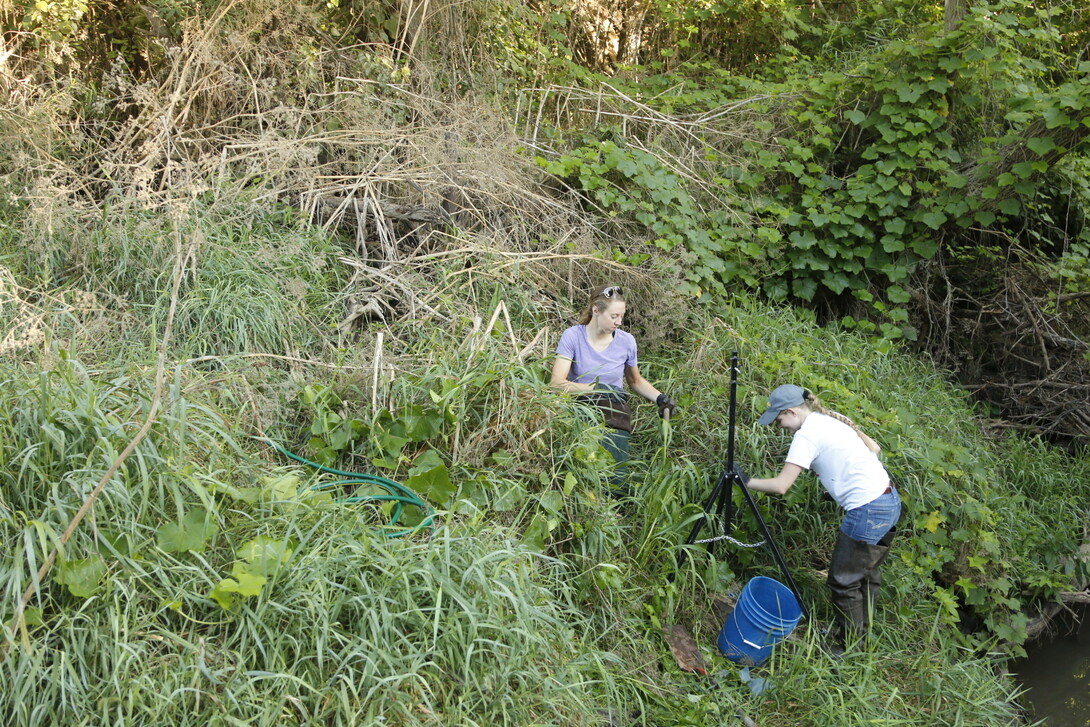
Lincoln, Neb. —Five past Nebraska students returned by Zoom on November 9, telling current students that taking part in the National Science Foundation Research Traineeship boosted their careers.
“For my position, my degree was in engineering, and for me to qualify to work as a soil conservationist, on paper, wouldn't have worked if I was not a part of the NRT,” Jessica Knox said.
Knox took part in the interdisciplinary NRT graduate program from August 2018 to May 2020 while earning her master’s degree in agricultural and biological systems engineering. Upon graduating, she took a position with the Natural Resources Conservation Service as a soil conservationist.
“The fact that I was able to have such a wide array of other coursework outside of engineering that was including natural resources helped me get that federal position and, probably also, because it's a National Science Foundation-funded program, the NRT was, on a day-to-day basis, using a lot of the language that I used in my resume,” she said.
She said these “buzzwords” showed federal workers at the NRCS that she was on the same page as them. She recently advanced to a field engineer position at the NRCS office in Valentine.
From Knox’s same NRT cohort, Brittany Decker also graduated in 2020, with an agronomy degree, and became a soil conservationist. Decker said the NRT emphasis on collaborations helped prepare her for her current work.
“For me, in grad school, there was a lot of juggling of a lot of different projects with different priorities, which is very similar to what I have to do now,” she said. “And then also the collaboration aspect of working with people from all different backgrounds in grad school to working with a lot of different types of producers here in my current job, as well as different people within the agency that have a lot different background experience than me or different positions.”
Another agronomy graduate, Alison Ludwig, took a position with the NRCS as a business tools specialist. She works with people at all levels of the agency on using programs such as ArcMap and Conservation Desktop.
“The collaborations of the NRT gave me those skills to just work with other people more efficiently,” Ludwig said.
Rubi Quiñones said Southern Illinois University Edwardsville showed much interest in the NRT interdisciplinary projects she had taken part in as a doctoral student and hired her as a computer science professor from a pool of about 120 applicants.
“They were really looking for faculty that had the experience of collaborating, that were capable of not only doing research in computer science but translating that, if needed, to plant scientists and just have more breadth in research that I could do,” she said. “The one thing they really liked about the NRT was the collaborations.”
Sydney Allen, a civil engineer who now works in accident reconstruction, said the interdisciplinarity of the NRT allowed her to take a science communication class she probably would not have been able to otherwise. That class proved one of the most useful, she said, as she writes 10- to 20-page reports on her findings on a motor accident.
“I basically write a tiny thesis all the time,” she said.
Allen had worked in accident reconstruction while an undergraduate in South Dakota and, after moving to Nebraska, sent an unsolicited letter of employment to her current employer, Nebraska Accident Reconstruction. She worked for it as needed as a master’s student and, upon graduating, became a partner and co-owner of the company.
Knox, Decker and Ludwig went through the USAJOBS portal to find their positions, and Quiñones found her position after applying for three professorships advertised in the Nebraska School of Computing.
Of the three universities Quiñones chose, Southern Illinois University Edwardsville interviewed her first and offered her a tenure-track position.
“A lot of people they do so many interviews and use like the first couple as a trial-and-error so they can get better at the talks,” Quiñones said. “Finally, they save the ones they really want for last so they can be the best there. So, I was just the odd gem that the first one I interviewed was the first one I got.”
All five students found work related to their interests either upon graduating or shortly afterward.
For students interested in working for the NRCS in similar positions, Ludwig suggested taking courses in GIS, plants and soil health and management. Decker suggested taking a course in grazing and rangeland. Knox said she wished she had taken more design and drafting courses in engineering.
“That's something that I feel I have not a lot of experience doing, but I'll learn how to do it,” Knox said. “And that's one thing that I'm thankful for all of my schooling is that I've learned how to learn and I'm never going to stop learning. So, I'll figure it out.”
Other graduated NRT students not on the panel either went on to earn their doctoral degrees, took a postdoctoral position or accepted jobs with the Center for Disease Control, Nebraska Department of Environment and Energy, United States Forest Service or United States Geological Survey.
Craig Allen, director of the Nebraska NRT, said he enjoyed hosting the panel and seeing and hearing from past students.
“It's good to see people out and about and in jobs that they seem to be pretty satisfied in,” he said. “Often, your first job is to get the foot in the door and then move on once you get secure that you can get employed and then build up from there, but it sounds like people jumped into positions they probably will move on from at some point once they are comfortable, which is important.”







